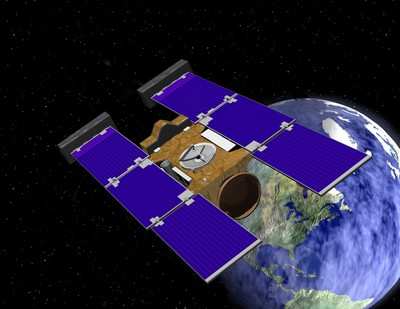Wed, Jan 14, 2009
Intrepid Spacecraft Enroute To Rendezvous With Comet Tempel
1
On January 14, NASA's Stardust-NExT spacecraft will fly by Earth
during a gravity assist maneuver that will increase its velocity
and sling shot the spacecraft into an orbit to meet up with comet
Tempel 1 in February 2011.

Flight operations for the spacecraft are performed from Lockheed
Martin's Mission Support Area in Denver, CO. The Jet Propulsion
Laboratory in Pasadena, CA provides the precision navigation need
for the flyby and the journey to Tempel 1.
The Lockheed Martin-built spacecraft's closest approach will
happen at 12:33 p.m. MST as it comes within 5,690 miles of
Earth. At its closest point, the spacecraft will fly over the
California/Mexico border south of San Diego at a speed of
approximately 22,400 miles per hour (36,000 kilometer per
hour).
"We performed our final trajectory correction maneuver on
January 5 that put us into a precise position for the flyby," said
Allan Cheuvront, Stardust-NExT program manager at Lockheed Martin
Space Systems Company. "On January 10, we sent the last set of
commands to the spacecraft that it will use to perform the gravity
assist maneuver. We're in great shape and we're looking forward to
seeing Stardust fly by before it heads back into deep space."
This isn't the first time Stardust has flown by Earth. The first
was January 15, 2001 when it used the Earth for a gravity assist to
meet up with comet Wild 2. Five years later on January 15, 2006,
the spacecraft flew by Earth
as it released its sample return capsule safely back to
Earth, which held particles from comet Wild 2 and
interstellar dust.
The Stardust-NExT (New Exploration of Tempel) mission is a
low-cost mission that will expand the investigation of comet Tempel
1 initiated by NASA's Deep Impact spacecraft. The mission uses the
still-healthy Stardust spacecraft to perform a flyby of comet
Tempel 1 and obtain high-resolution images of the coma and nucleus,
as well as measurements of the composition, size distribution, and
flux of dust emitted into the coma. Stardust-NExT will also provide
important new information on how Jupiter family comets evolve and
how they formed 4.6 billion years ago.
More News
Aero Linx: Model Aeronautical Association of Australia MAAA clubs are about fun flying, camaraderie and community. For over 75 years, the MAAA has been Australia’s largest fl>[...]
Touchdown Zone Lighting Two rows of transverse light bars located symmetrically about the runway centerline normally at 100 foot intervals. The basic system extends 3,000 feet alon>[...]
“Discovery and innovation are central to our mission at Virgin Galactic. We’re excited to build on our successful record of facilitating scientific experiments in subor>[...]
How To Get A Story On Aero-TV News/Feature Programming How do I submit a story idea or lead to Aero-TV? If you would like to submit a story idea or lead, please contact Jim Campbel>[...]
Student Pilot Reported That During Rotation, “All Of A Sudden The Back Of The Plane Kicked To The Right..." Analysis: The student pilot reported that during rotation, “>[...]
 ANN's Daily Aero-Linx (05.02.24)
ANN's Daily Aero-Linx (05.02.24) ANN's Daily Aero-Term (05.02.24): Touchdown Zone Lighting
ANN's Daily Aero-Term (05.02.24): Touchdown Zone Lighting Aero-News: Quote of the Day (05.02.24)
Aero-News: Quote of the Day (05.02.24) ANN FAQ: Contributing To Aero-TV
ANN FAQ: Contributing To Aero-TV NTSB Final Report: Cirrus Design Corp SR20
NTSB Final Report: Cirrus Design Corp SR20



